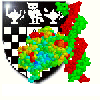PPS Self-Assessment Exercises: Answers
Note: Many of you have produced answers which were rather longer than
these here! We were only looking for short answers: not essays ;) So the
model answers given here have rather less information than many of you
provided.
- "Hydrophobicity": the tendency of non-polar (aromatic and aliphatic)
amino acids to avoid water.
- Proline a) cannot adopt the phi and psi angles required for an alpha
helix, and b) has no NH group which could be bonded to a C=O group in the
previous turn of the helix. Therefore it either breaks or kinks the
helix.
- Non-hydrogen atoms in amino acid side chains which are four atoms apart
(i.e. A,D in A-B-C-D) avoid eclipsed conformations.
- Information includes: author, reference (hyperlinked to Medline); gene
sequence (hyperlinked to main gene sequence databases); links to other
databases e.g. PDB for structure, ProDom for domains, PROSITE / PRINTS for
sequence patterns. Functional information if this is known.
- Protein sequence pattern databases: PROSITE, PRINTS, BLOCKS
- Static images: GIF (and similar). Helper applications: Rasmol (also
Mage). Plugins: Chime. Video / animation: QuickTime etc.
- Building blocks of DNA: this is an ambiguous question ;) *Three* major
"building blocks": deoxyribose, base, phosphate. Counterions and water
are also important. Four bases - A,T,G,C for DNA.
- rRNA: ribosomal RNA, a structural component of ribosomes
tRNA: anticodon loop recognises the mRNA codons and carries an
aminoacyl group which is transferred to the nascent polypeptide chain
mRNA: transcribed from DNA; contains the ribonucleotide triplets which
code for the amino acids
- The lac operon is a contiguous segment of DNA consisting of two control
sites - the operator and the promoter - and three structural genes
(beta-galactosidase, permease and transacetylase). A regulator gene
upstream (N-terminal) of the operon produces the repressor protein.
Transcription of the structural genes is prevented by the repressor
binding to the operator.
- Signal Recognition Particles are ribonucleoproteins (assemblies of one
RNA molecule and six separate polypeptide chains). They bind only to
ribosomes containing nascent polypeptide chains with signal sequences and
deliver those ribosomes to the endoplasmic reticulum (ER). The nascent
protein is then threaded across the ER membrane.
- Translation: 64 (=4^3) possible 3-base codons from 4 bases. Triplets
are recognised by tRNA anticodons. There are three codons used as
terminators in the standard gentic code: UAG, UAA, UGA. (These are
recognised by proteins called release factors which release the nascent
polypeptide chains from the ribosomes.)
In eukaryotes AUG closest to the 5' end of a mRNA is the signal for
initiating protein synthesis. The AUG is read by an initial tRNA which is
loaded with methionine.
- Glycine residues offer the possibilities of phi and psi angles which
cannot be adopted by other residues. Hence a substitution of Gly by
another residue may well change the local secondary structure of the
protein and destabilise its overall structure.
- R-H alpha helix: phi -60 to 180 degrees; psi -20 to -80 degrees
beta strand: phi 20 to -170 degrees; psi -60 to 180 degrees
L-H alpha helix: phi 70 to 80 degrees; psi 20 to 90 degrees
- There was an error in the original question which we corrected to:
"Why are cations bound to the C-terminal end of alpha helices?" The answer
is that the C-terminal end of an alpha helix carries a partial negative
charge, the result of the summation of all the dipoles created by parallel
NH and C=O groups
- Trp has a much larger volume than Asp
Trp is uncharged at physiological pH whereas Asp is negatively
charged
Trp can act as a hydrogen bond donor only, and Asp as an acceptor
only
A codon coding for Trp cannot be changed into one coding for Asp by
a single base mutation
- Hydrophobic interactions are most important. (It is energetically
favourable for proteins with surface patches of largely hydrophobic
residues to associate together in aqueous solution.)
- The main chain nitrogen carries a partial positive charge due to the
partial double bond character of the main chain C-N bond. This means that
the addition of an extra proton to the main chain NH is more difficult
than the addition of one to the side chain nitrogen: hence it has a lower
pKa.
- Interior: Val, Phe, Pro
Exterior: Asp, Lys, His
Intermediate: Gly
- Peptide mapping segregates amino acids on the basis of their charge
and polarity. Arg and Lys are both basic amino acids with the same charge
and similar polarity. It will therefore be difficult to sequence proteins
containing many Arg and Lys residues, such as histones, using this
technique.
- Isoleucine (S); Threonine (R)

